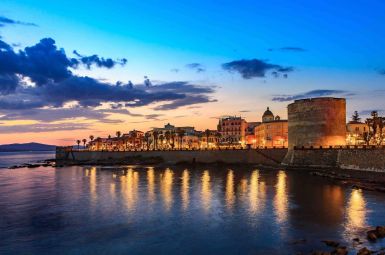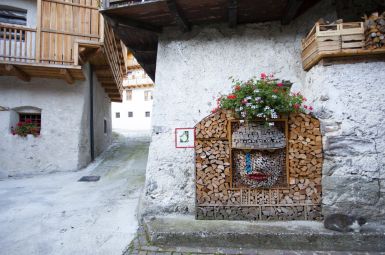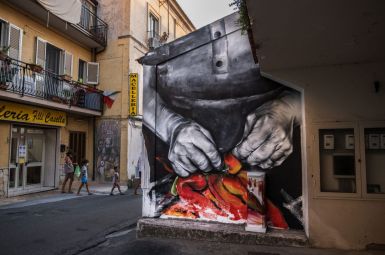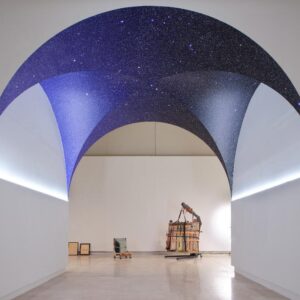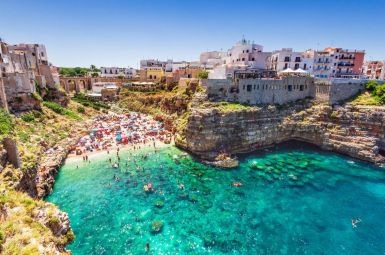
Il Borgo di Matera
Matera: Dove la Storia si Scrive nella Roccia
Sei pronto a fare un passo indietro nel tempo, dove l’architettura si fonde con la geologia e ogni pietra racconta una storia millenaria? Matera non è solo una città; è un’esperienza, un miracolo architettonico scolpito nel cuore della Basilicata. Dimentica i soliti itinerari: qui, ti addentrerai in un paesaggio culturale unico, riconosciuto come Patrimonio Mondiale UNESCO e celebrato come Capitale Europea della Cultura 2019.I Sassi: Un Viaggio alle Origini dell’Uomo
I Sassi di Matera – il Sasso Barisano e il Sasso Caveoso – sono il suo cuore pulsante e il motivo della sua fama globale. Non sono semplici case: sono un labirinto di grotte naturali modellate dall’uomo sin dal Paleolitico, un intreccio di dimore, cisterne e chiese rupestri dove il tetto di un’abitazione diventa il vicolo dell’altra.- Sasso Caveoso: L’anima più antica e suggestiva, con un aspetto che ricorda una cavea teatrale, dove l’habitat rupestre si mostra nella sua forma più atavica e commovente.
- Sasso Barisano: Più articolato e rimaneggiato nel tempo, ricco di dettagli architettonici, portali scolpiti e facciate che celano il cuore sotterraneo.
Oltre i Sassi: Fede, Arte e Paesaggio
L’esperienza materana prosegue oltre il nucleo storico. Sulla Civita, lo sperone roccioso che divide i due Sassi, domina maestosa la Cattedrale di Maria Santissima della Bruna. Ma è il paesaggio circostante a lasciare senza fiato:- Parco della Murgia Materana: Di fronte ai Sassi, al di là della profonda Gravina, si estende un altopiano roccioso costellato da oltre 150 chiese rupestri magnificamente affrescate, come l’iconica Cripta del Peccato Originale. Un vero e proprio parco archeologico e naturale che offre i punti panoramici più emozionanti sulla città, come il Belvedere di Murgia Timone.
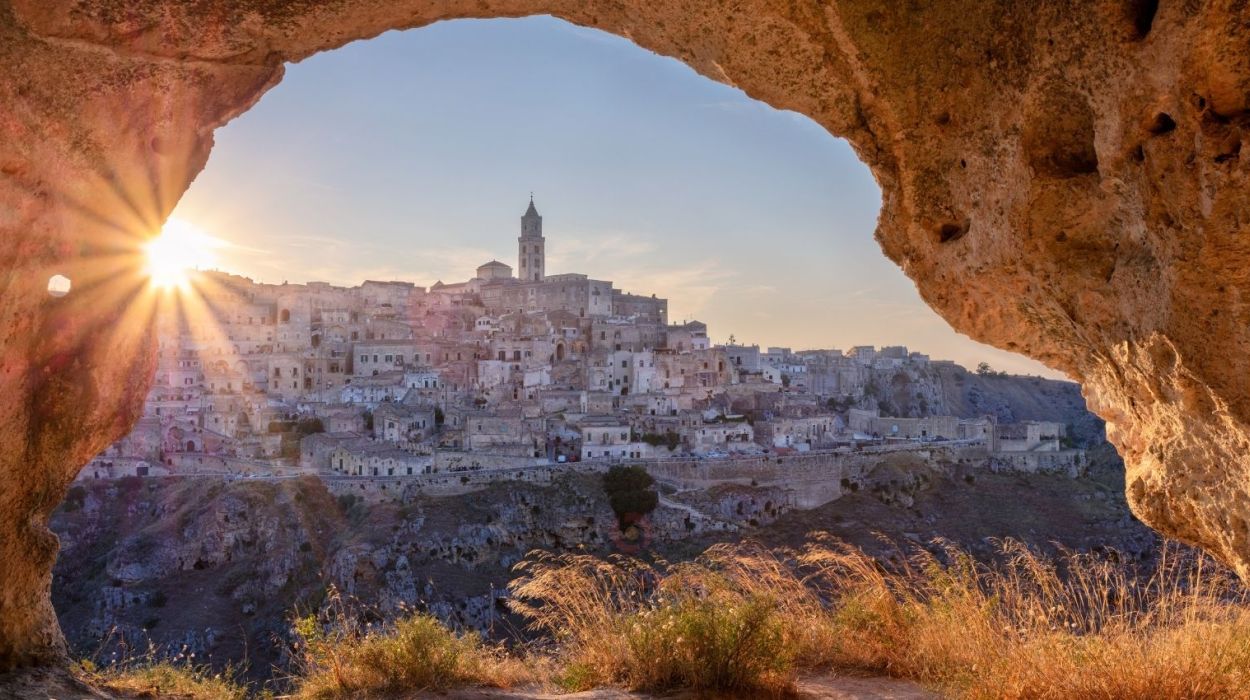
Il Borgo d’Italia
tutto da scoprire ed esplorare
Monumenti
Matera: Un Viaggio Attraverso il Tempo in 7.000 Anni
Matera non è solo una città, è un’epopea. Pochi luoghi al mondo offrono la possibilità di attraversare millenni di storia con un solo passo. Qui, i muri di tufo non sono solo roccia: sono capitoli di una saga umana, un’evoluzione continua che celebra la resilienza e l’ingegno.
Ecco i momenti che hanno plasmato l’identità unica della Città dei Sassi, rendendola una meta imprescindibile:
1. La Nascita Troglodita: L’Uomo e la Roccia
Il primo, fondamentale momento di Matera risale al Paleolitico. La città nasce dalla scelta primordiale dell’uomo di abitare le grotte naturali della Murgia. L’insediamento non è casuale: è un’interazione geniale con l’ambiente. I primi abitanti non costruiscono sulla roccia, ma nella roccia, scavando, modellando e adattando l’habitat naturale. Questo atto fondativo crea la matrice unica dei Sassi, un organismo urbano in cui il tetto di un’abitazione diventa il sentiero di un’altra.
2. L’Era Rupestre: Fede e Comunità
Tra l’Alto Medioevo e l’Età Moderna, i Sassi fioriscono. Questo è il momento della Civiltà Rupestre. Monaci e comunità contadine trasformano le caverne in raffinate Chiese Rupestri, veri e propri scrigni d’arte con affreschi bizantini che ancora oggi lasciano senza fiato (come nella Cripta del Peccato Originale). I Sassi si strutturano in “vicinati”, dove la vita si svolge in una densa e solidale socialità, con i sistemi idrici del Palombaro Lungo a testimoniare un’ingegneria idraulica d’avanguardia.
3. L’Oscurità e la “Vergogna Nazionale” (XX Secolo)
Dopo secoli di crescita e stratificazione, arriva il momento più doloroso. Nel dopoguerra, l’isolamento e il sovraffollamento trasformano l’unicità dei Sassi in un simbolo di degrado e povertà, definiti da Palmiro Togliatti la “vergogna nazionale”. Questo porta alla Legge Speciale del 1952 e al conseguente sfollamento degli abitanti verso i nuovi quartieri. Un momento cruciale che segna una cesura: il dolore dell’abbandono pone le basi per la rinascita.
4. La Rinascita e il Riconoscimento UNESCO (1993)
Il vero punto di svolta. Dopo decenni di oblio e riqualificazione, il mondo riconosce il valore inestimabile di Matera. Nel 1993, i Sassi vengono dichiarati Patrimonio Mondiale dell’Umanità UNESCO con una motivazione storica: sono un “paesaggio culturale” eccezionale e la “più integra testimonianza di insediamento umano troglodita del Mediterraneo”. Matera smette di guardare al passato come un peso e inizia a proiettarsi come un modello di recupero.
5. Capitale Europea della Cultura (2019)
Il culmine della sua rinascita globale. Essere nominata Capitale Europea della Cultura per il 2019 ha consacrato Matera come un laboratorio culturale vivente e un simbolo di riscatto. L’evento ha portato investimenti, creatività e un’ondata di visitatori internazionali, trasformando le antiche grotte in alberghi diffusi, centri espositivi e boutique. È il momento in cui Matera si afferma definitivamente come un ponte tra passato e futuro.
Matera oggi non è solo storia conservata; è ispirazione viva. È il luogo dove puoi toccare la preistoria al mattino e sorseggiare un aperitivo di design in una grotta la sera.
Sei pronto a vivere la storia che ti aspetta in ogni vicolo dei Sassi?
Curiosità
Matera Segreta: Le Curiosità che Rendono i Sassi Leggendari
Credevi di conoscere Matera? Ti sbagliavi. Dietro la sua maestosa bellezza UNESCO si nascondono storie, ingegneria nascosta e leggende che trasformano ogni visita in una vera esplorazione.
Ecco il lato meno conosciuto, ma più affascinante, della Città dei Sassi:
1. La Città Interamente Sotterranea
I famosi Sassi sono solo la punta dell’iceberg. Sotto il Piano, il quartiere moderno, si cela una Matera completamente invisibile. È il capolavoro dell’ingegneria idraulica antica: il Palombaro Lungo, un’immensa cattedrale sotterranea interamente scavata nel tufo. Non era una cisterna comune, ma il serbatoio principale della città, un sistema idrico così ingegnoso da garantire l’acqua per secoli, dimostrando che l’antica Matera era un prodigio di autosufficienza “bio-architettonica”.
2. Dalla “Vergogna” al Set Cinematografico
La storia di Matera è un incredibile riscatto. Dopo essere stata definita la “vergogna nazionale” a causa delle condizioni di vita nel dopoguerra, la città è risorta, diventando la location prediletta dai grandi registi. Matera è stata la perfetta e drammatica ambientazione per film come Il Vangelo secondo Matteo di Pasolini e Cristo si è fermato a Eboli. Ancora oggi, è spesso scelta per rappresentare l’antica Gerusalemme (ad esempio in The Passion e nell’ultima versione di Ben-Hur) o persino per scenari più recenti, come le scene d’inseguimento di James Bond in No Time to Die.
3. I Tetti Che Diventano Strade (E Viceversa)
Nei Sassi, la prospettiva è ribaltata. Qui, il concetto di “vicinato” raggiunge la sua massima espressione: il tetto di una casa è il pavimento del vicolo superiore. Camminando, non sai mai se ti trovi sopra un’abitazione, una cisterna o un’antica grotta. Questo sistema a cascata non è solo scenografico, ma è l’essenza stessa della sua architettura troglodita, una complessa stratificazione che ha permesso alla città di espandersi verticalmente e orizzontalmente per millenni.
4. Il Pane di Matera: L’Oro Giallo della Tradizione
A Matera, anche il cibo è storia. Il celebre Pane di Matera IGP non è un semplice alimento, ma un simbolo di identità. Prodotto con semola di grano duro, ha una forma inconfondibile che ricorda le montagne della Murgia. La curiosità? Anticamente, ogni famiglia incideva sul pane un piccolo timbro in legno (spesso a forma di croce) per distinguerlo dagli altri, prima di portarlo a cuocere nel forno comune del vicinato. Un rituale che testimonia la sua profonda cultura contadina.
5. La “Casa Grotta”: Un Microcosmo di Vita Reale
Visitando una Casa Grotta musealizzata, si scopre che le grotte non erano solo umili rifugi, ma veri e propri ecosistemi complessi. Le famiglie vivevano in spazi unici con gli animali domestici (soprattutto l’asino, fondamentale per il trasporto) non per negligenza, ma per sfruttare il calore corporeo e mantenere l’ambiente interno più mite durante le fredde notti invernali. Una strategia di sopravvivenza pragmatica e ingegnosa, tipica della civiltà rupestre.
Matera è la prova che la vera ricchezza non sta nel lusso, ma nell’ingegno e nella storia. Scopri la città che ha sfidato il tempo e riscritto il suo destino.
Personaggi
Matera, Culla di Geni: I Nomi Che Hanno Illuminato la Storia
Matera è una fucina di storia e cultura, e la sua profonda identità ha nutrito personalità che hanno eccelso in ogni campo, dall’arte all’impegno sociale. Questi sono gli eredi dei Sassi, che hanno portato il genio lucano sulla scena nazionale e internazionale.
Gli Artisti e gli Intellettuali
Domenico Ridola (1841 – 1932): Il Medico che Scavò la Storia
Non un semplice medico, ma il vero pioniere dell’archeologia materana. Domenico Ridola è la figura chiave che, con passione instancabile e mezzi propri, ha riscoperto l’immensa ricchezza preistorica del territorio. I suoi scavi e le sue collezioni non solo hanno confermato l’antichità dei Sassi, ma sono diventati il nucleo del Museo Archeologico Nazionale che porta il suo nome. Un uomo la cui intuizione ha letteralmente dissotterrato le radici della città.
Giovanni Pascoli (1855 – 1912): Il Poeta Adozione
Sebbene non nativo, la figura di Pascoli è cruciale. Fu a Matera che il grande poeta trascorse un periodo significativo come insegnante presso il Liceo Classico. La sua permanenza lasciò un segno profondo, tanto che la splendida piazza panoramica che affaccia sui Sassi porta il nome di Piazzetta Pascoli, il luogo da cui si può ammirare il “presepio” architettonico della città.
I Protagonisti del Riscatto
Raffaele Giura Longo (1930 – 2018): Il Sindaco della Rinascita
È una delle figure politiche più decisive per la storia recente di Matera. Fu il Sindaco che non solo gestì il delicato e difficile sfollamento dei Sassi, ma ne avviò il primo, fondamentale processo di recupero e valorizzazione. Giura Longo comprese per primo che i Sassi non erano una “vergogna”, ma un Patrimonio da salvare. La sua visione fu il presupposto per il futuro riconoscimento UNESCO.
Francis Ford Coppola (Nato a Detroit, con radici a Bernalda, MT): Il Legame Cinematografico
Non nativo di Matera, ma l’intera Basilicata rivendica con orgoglio il legame con il regista premio Oscar. Le sue radici familiari, che affondano nella vicina Bernalda (MT), hanno creato un ponte indelebile tra Hollywood e il Sud Italia, proiettando una luce internazionale sulla regione e rafforzando il ruolo di Matera come capitale cinematografica del Mezzogiorno.
Le Nuove Voci Contemporanee
Eustachio “Tachi” Montemurro (Nato a Matera): Il Volto dell’Identità Lucana
Attore e regista teatrale, è una delle voci più autentiche della cultura materana contemporanea. Attraverso il suo lavoro, Tachi Montemurro ha saputo raccontare con ironia, passione e profondità la vita, le tradizioni e le sfide della Basilicata, diventando un importante ambasciatore artistico dell’identità lucana.
Matera è la città che ha insegnato al mondo a guardare con occhi nuovi il passato. Questi personaggi, ognuno a suo modo, hanno contribuito a scolpire il futuro della città, rendendola l’icona di resilienza e bellezza che è oggi.
Quale di queste storie ti ispira di più per il tuo viaggio tra i Sassi?
Ricette Tipiche
La Cucina dei Sassi: Il Sapore Autentico della Terra Lucana
Dimentica il fast food. A Matera, la cucina è un viaggio a ritroso nel tempo, dove la semplicità si trasforma in capolavoro e ogni piatto racconta la storia di una civiltà contadina resiliente e ingegnosa.
I sapori di Matera sono genuini, forti e indissolubilmente legati ai prodotti della terra e alla tradizione povera, che qui ha saputo trasformare ingredienti umili in vere e proprie esperienze gastronomiche.
1. Cialledda: L’Antipasto che sa di Storia
Il piatto che celebra l’ingegno contadino. La Cialledda è l’antipasto perfetto per iniziare l’esperienza materana. Ne esistono due versioni, entrambe basate sull’idea di non sprecare nulla:
- Cialledda Fredda (o acquasale): Si prepara con Pane di Matera IGP raffermo (il vero protagonista), inumidito con acqua, condito con sale, olio EVO locale, pomodorini e origano. Una zuppa estiva, fresca, che esalta il sapore del pane con la semplicità degli ortaggi.
- Cialledda Calda: Una variante invernale che vede il pane immerso in brodo vegetale o di legumi, spesso arricchita con uova in camicia. È la quintessenza del “mangiare povero” trasformato in conforto per l’anima.
2. Lagane e Ceci: La Pasta Ru(vida) e l’Oro della Murgia
Il primo piatto che non puoi saltare. Le Lagane sono un formato di pasta fresca, un antenato delle tagliatelle, preparate senza uova, con acqua e farina di grano duro. La loro consistenza ruvida è perfetta per raccogliere il condimento più iconico di Matera: i Ceci della Murgia.
Il piatto, Lagane e Ceci, è un inno alla dieta mediterranea: le lagane vengono saltate con i ceci (spesso cotti in un tegame di terracotta, la pignata), aglio, alloro e abbondante olio d’oliva. Un sapore rustico, appagante e profondamente legato al ciclo agricolo del territorio.
3. Crapiata Materana: La Festa del Raccolto nel Piatto
Più di una zuppa: un simbolo di unità. La Crapiata è il piatto tradizionale che veniva preparato a Matera in occasione della festa del raccolto (celebrata il 1° agosto). Storicamente, ogni famiglia portava un po’ del proprio raccolto al forno comune, creando una zuppa collettiva.
- Gli ingredienti: Un mix robusto di legumi e cereali—grano, ceci, lenticchie, fagioli, cicerchie e fave.
- Il significato: Non è solo una ricetta, ma un atto sociale che simboleggia l’unione e la condivisione tra i vicinati dei Sassi. È un sapore che unisce la comunità.
4. Pezzente della Montagna: Il Salume Che non si Scarta
Il salume che racconta la storia. Il Pezzente, detto anche Salsiccia Pezzente, non è un taglio di carne, ma una filosofia. È un salume preparato con i tagli di carne meno nobili (da cui il nome), ma aromatizzato con una quantità generosa di peperoncino, finocchietto selvatico e altre spezie locali. Il risultato è un sapore intenso e piccante. Viene gustato sia fresco che stagionato, ed è spesso l’ingrediente segreto per arricchire il sugo di carne.
Lasciati conquistare da una cucina che ha saputo resistere al tempo. A Matera, ogni boccone è un tuffo nella storia.
Sei pronto ad assaporare l’autentica tradizione lucana?
